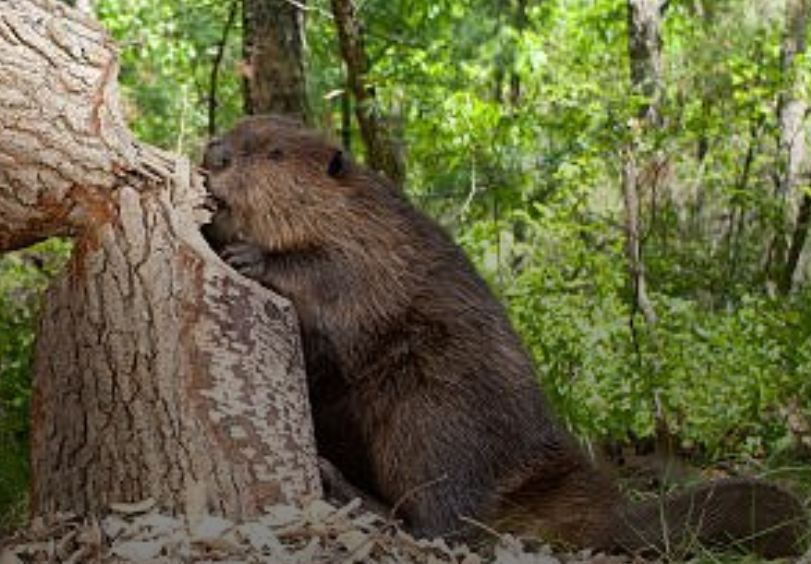I’m so old today that I can remember when the daily Kos was the shiny new thing and Markos himself was on meet the press Those days are long gone but apparently left a highwater mark because look what I found yesterday…

Hi! I’m a long-time lurker! In April 2021, I was minding my own business, watching TV with my husband, when I scrolled through Facebook and discovered that there was a family of beavers in my Chicagoland suburb that was about to be trapped and killed by an HOA because they were damaging trees. Humans confuse me. They plant amazing natural settings and then get mad when nature moves in. Anyway, a group of us sprang into action. We created a Facebook group, wrote a press release, talked to the media, held a rally, and got the HOA to agree not to trap and kill the beavers.
Hey that sounds familiar doesn’t it.
But then I started thinking. “My” beavers were going to have babies (kits) who eventually were going to disperse, and then those juvenile beavers would be at risk of being trapped and killed. I read Ben Goldfarb’s book, Eager: The Surprising, Secret Life of Beavers and Why They Matter, and I knew what I needed to do. Obviously, I needed to form a nonprofit, the Illinois Beaver Alliance, and I needed to go to graduate school and get a certificate in Environmental Law & Policy so I would have some qualifications to become a beaver advocate. So I did!
Wow. I know that story too. Hey this is Rachel Schick Siegel. What a great place to tell the story.
Beavers are amazing ecosystem engineers who provide valuable ecosystem services for humans. Beaver ponds purify water; recharge aquifers; raise water tables; create habitat for fish, birds, amphibians, and mammals; and create floodwater storage capacity. Beaver ponds don’t burn, so more beavers would help combat wildfires in arid regions. In fact, more beavers would help us develop climate resilience in the face of climate change. And they are skilled engineers who work for free. Beaver restoration, a type of low-tech, process-based river restoration, is being used out west to restore salmon habitat; and in the Plains states to raise water tables for livestock.
I like this story! I may start reading the daily Kos again!
So I started to think about Illinois environmental problems, and I realized that while we are trapping and killing hundreds of “nuisance” beavers every year (not to mention the thousands being trapped for their pelts, with no bag limits), we are also spending $25 million+ per year on our “Nutrient Loss Reduction Strategy.” The Nutrient Loss Reduction Strategy, aimed at reducing point source pollution (wastewater and stormwater treatment facility discharge) and nonpoint source pollution (agricultural runoff) from entering out watersheds, which then feed into the Mississippi River, which then feeds into the Gulf of Mexico and causes a big dead zone, is at some level a failure—every year we fall further behind in our goals. But what if we had wider riparian buffers, with more beaver wetlands to filter out the nitrogen and phosphorus? We have water quality issues, we have loss of habitat which leads to loss of biodiversity, and we also will have a lot more flooding in upcoming years due to anthropogenic climate change leading to changing precipitation patterns.
So what if, instead of trapping and killing all of those beavers, we coexisted with them instead, using proven tools such as culvert fencing and pond levelers to prevent flooding that would damage human infrastructure? You can find out more about “flow devices” at the Beaver Institute website!
Yeah what if we did it right instead of stupid? Go Rachel.
Anyway, the Illinois Beaver Alliance, along with the Superior Bio-Conservancy in Wisconsin, has been planning a virtual, two-day Midwest Beaver Summit. We held our first day last week. Here is an article about it that appeared in the Chicago Tribune. It’s behind a paywall, though, so you can access it elsewhere; here is one reprint in the Seattle Times.
The second day is tomorrow, and you are invited to register! Midwest Beaver Summit Registering will also gain you access to the videos recordings of all the presentations.
Last week, Dr. Emily Fairfax and author Leila Philip both gave presentations. They were also featured on CBS This Morning last Sunday. Here is the link to that segment.
Anyway, I hope to see you tomorrow at Day 2 of the Midwest Beaver Summit, and that I can convince some of you to become Beaver Believers!!! Currently there are 795 registrants for the event. We have hundreds of people signed up who work for state and federal natural resource management agencies, land trusts, environmental nonprofits, watershed groups, and other stakeholders, from the Midwest states in general and across the entire nation!
Go Rachel! And Go Midwest Beaver Summit! What a great birthday present for me and beavers everywhere.



 SPRINGFIELD, Ill. – Illinois State Senator Patrick Joyce, D-Essex, has proposed a bill aimed at protecting beavers and regulating the activities of nuisance wildlife operators.
SPRINGFIELD, Ill. – Illinois State Senator Patrick Joyce, D-Essex, has proposed a bill aimed at protecting beavers and regulating the activities of nuisance wildlife operators.  In addition to getting the people of Glenview to care about beavers and starting a nonprofit to protect them, she has met with the local representative AND Fish and game to put beavers on the radar if everyone involved. She even adapted our handout about urban beavers for the state, complete with articles by a local expert. Rachel is full of power moves. If I were a beaver in Illinois I’d be feeling pretty confident right about now.
In addition to getting the people of Glenview to care about beavers and starting a nonprofit to protect them, she has met with the local representative AND Fish and game to put beavers on the radar if everyone involved. She even adapted our handout about urban beavers for the state, complete with articles by a local expert. Rachel is full of power moves. If I were a beaver in Illinois I’d be feeling pretty confident right about now. I have emerged unscathed from my meeting with the IEPA today! With the help of Representative Jen Gong-Gershowitz, I was able to make a polished pitch about the role that process-based restoration (and beavers!) can play in improving our water quality and creating floodwater storage capacity.
I have emerged unscathed from my meeting with the IEPA today! With the help of Representative Jen Gong-Gershowitz, I was able to make a polished pitch about the role that process-based restoration (and beavers!) can play in improving our water quality and creating floodwater storage capacity. sponsored project of Inquiring Systems, Inc. , and thus has nonprofit status.The mission of the Illinois Beaver Alliance is to improve the health and function of Illinois watersheds, which will increase climate resilience, improve water quality, increase biodiversity, and create floodwater storage capacity; and to educate the public about the ecological importance of beavers and the modern tools for resolving human-beaver conflicts. I’ll tell you more about it soon!
sponsored project of Inquiring Systems, Inc. , and thus has nonprofit status.The mission of the Illinois Beaver Alliance is to improve the health and function of Illinois watersheds, which will increase climate resilience, improve water quality, increase biodiversity, and create floodwater storage capacity; and to educate the public about the ecological importance of beavers and the modern tools for resolving human-beaver conflicts. I’ll tell you more about it soon!




































